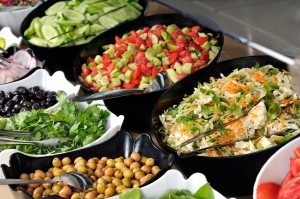நா. சிபிச்சக்கரவர்த்தி, ஓவியம்: ஹாசிப்கான்
 'கெட்டுப்போன
ஆட்டு இறைச்சி பிடிபட்டது’ என்பது செய்தித்தாள்களில் நாம் அடிக்கடி
படிக்கும் செய்தி. கடந்த மாதம்கூட ராஜஸ்தான் மாநிலம் ஜெய்ப்பூரில் இருந்து
கொண்டுவரப்பட்ட 3,300 கிலோ ஆட்டு இறைச்சி அழுகிக் கெட்டுப்போன நிலையில்,
சென்னை சென்ட்ரல் ரயில் நிலையத்தில் அதிகாரிகளால் பிடிக்கப்பட்டது.
புழுத்துப்போய் துர்நாற்றம் வீசிய அந்த இறைச்சியை, கொடுங்கையூர்
குப்பைக்கிடங்கில் குழி தோண்டிப் புதைத்தனர். உண்மையில் அந்த இறைச்சி
சென்றுசேர்ந்திருக்க வேண்டிய இடம் குப்பைக்கிடங்கு அல்ல; நம் வயிறு.
மிகைப்படுத்திச் சொல்லவில்லை. ஒவ்வொரு நாளும் வட மாநிலங்களில் இருந்து
ஆயிரக்கணக்கான கிலோ ஆட்டு இறைச்சி சென்னைக்குக் கொண்டுவரப்படுகிறது. அதில்
கணிசமானவை, கெட்டுப்போனவை. என் றைக்கோ ஒரு நாளைக்குத்தான் பிடிக்கிறார்கள்
என்றால், மற்ற நாட்களில் அவை எங்கு சென்று சேர்கின்றன?
'கெட்டுப்போன
ஆட்டு இறைச்சி பிடிபட்டது’ என்பது செய்தித்தாள்களில் நாம் அடிக்கடி
படிக்கும் செய்தி. கடந்த மாதம்கூட ராஜஸ்தான் மாநிலம் ஜெய்ப்பூரில் இருந்து
கொண்டுவரப்பட்ட 3,300 கிலோ ஆட்டு இறைச்சி அழுகிக் கெட்டுப்போன நிலையில்,
சென்னை சென்ட்ரல் ரயில் நிலையத்தில் அதிகாரிகளால் பிடிக்கப்பட்டது.
புழுத்துப்போய் துர்நாற்றம் வீசிய அந்த இறைச்சியை, கொடுங்கையூர்
குப்பைக்கிடங்கில் குழி தோண்டிப் புதைத்தனர். உண்மையில் அந்த இறைச்சி
சென்றுசேர்ந்திருக்க வேண்டிய இடம் குப்பைக்கிடங்கு அல்ல; நம் வயிறு.
மிகைப்படுத்திச் சொல்லவில்லை. ஒவ்வொரு நாளும் வட மாநிலங்களில் இருந்து
ஆயிரக்கணக்கான கிலோ ஆட்டு இறைச்சி சென்னைக்குக் கொண்டுவரப்படுகிறது. அதில்
கணிசமானவை, கெட்டுப்போனவை. என் றைக்கோ ஒரு நாளைக்குத்தான் பிடிக்கிறார்கள்
என்றால், மற்ற நாட்களில் அவை எங்கு சென்று சேர்கின்றன?
கடைசியாகப் பிடிபட்ட ஜெய்ப்பூர் இறைச்சியையே
எடுத்துக்கொள்வோம். சென்னையில் இருந்து ஜெய்ப்பூருக்கு 2,184 கி.மீ. அங்கு
கிளம்பும் ரயில் சென்னையை வந்தடைய முழுதாக 36 மணி நேரம் ஆகும். ஆடு
வெட்டப்பட்டு ரயிலில் ஏற்றப்படுவதற்கு முந்தைய நேரம், இங்கு சரக்கு
வந்ததும் இறக்கி வெளியில் எடுத்து வரும் நேரம் ஆகியவற்றைக் கணக்கிட்டால்,
குறைந்தது இரண்டு நாட்கள். வெட்டிய இறைச்சியை இவ்வளவு நேரம் வெளியில்
வைத்திருந்தால், அது கெட்டுப்போகும். ஆனாலும், இவர்கள் துணிந்து அதை
விற்பனை செய்கிறார்கள்.
ரயிலில், இறைச்சியைப் பதப்படுத்தி பாதுகாக்கும்
குளிர்பதனக் கிடங்கு வசதி எதுவும் இல்லை. சாதாரண அட்டைப் பெட்டியில்
அடைத்து, உள்ளே நாலு ஐஸ் கட்டிகளை வைத்து கட்டி அனுப்பிவிடுகிறார்கள். அது
சில மணி நேரங்களிலேயே துர்நாற்றம் வீச ஆரம்பித்துவிடுகிறது. நாம் ரயில்
நிலையங்களில் உணரும் இனம் காண முடியாத துர்நாற்றத்துக்கு, கெட்டுப்போன இந்த
இறைச்சிகளுக்கே பெரும் பங்கு. ஒவ்வொரு மாநிலமாக, நகரமாக மழை, வெயில்,
புழுதி கடந்து அந்த இறைச்சி சென்னையை வந்து சேரும்போது, விஷ மாகத்தான்
வந்து இறங்கும். அதன் பிறகு வெளியில் எடுத்து விநியோகம் செய்து,
சமைக்கப்பட்டு மட்டன் பிரியாணியாக, மட்டன் சுக்காவாக நம்மை வந்தடைகிறது.
கமகமக்கும் மசாலாவின் வாசனையிலும், சுள்ளென்ற காரத்தின் சுவையிலும், சூடான
உணவின் உணர்விலும் எல்லாம் மறக்கடிக்கப்படுகின்றன.
தமிழ்நாட்டில் ஆட்டு இறைச்சியின் விலை மிகவும் அதிகம்.
இன்றைய நிலையில் ஒரு கிலோ 480 ரூபாய் வரை விற்கப்படுகிறது. இது சாதாரண ஏழை
மக்களுக்கும், கீழ் நடுத்தர வர்க்கக் குடும்பத்தினருக்கும் பெரும் செலவு.
இருப்பினும் ஆட்டு இறைச்சி சாப்பிடுவோரின் எண்ணிக்கை அதிகம் என்பதால், அதன்
விலை தொடர்ந்து அதிகமாகவே உள்ளது. தேவைக்கு ஏற்ப ஆடு உற்பத்தி இங்கு இல்லை
என்பதும் அதிக விலைக்கு ஒரு காரணம். நகரமயமாதலில் நாட்டிலேயே நம்பர் 1- ஆக
இருக்கும் தமிழ்நாட்டில், தலைநகர் சென்னைக்கு மாநிலம் முழுவதும் இருந்து
மக்கள் கூட்டம் குவிகிறது. அவர்களில் கணிசமானோர் ஆட்டு இறைச்சிப்
பிரியர்கள். இதனாலேயே சென்னையில் அதன் தேவை அதிகம்.

ஆனால், வட மாநிலங்களில் நிலைமை வேறு. நாட்டின்
ஒட்டுமொத்த ஆடு உற்பத்தியில் 15 சதவிகிதத்துடன் முதல் இடத்தில் இருக்கிறது
ராஜஸ்தான். அங்கு மொத்தம் 2.15 கோடி ஆடுகள் இருக்கின்றன.
உத்தரப்பிரதேசத்தில் 10 சதவிகித ஆடுகளும், தமிழ்நாட்டில் 1.07 சதவிகித
ஆடுகளும் உள்ளன. அதிக ஆடுகளைக்கொண்டுள்ள ராஜஸ்தான் உள்ளிட்ட வட
மாநிலங்களில், பெரும் பகுதி மக்கள் சைவ உணவுப் பழக்கம் கொண்டவர்கள்.
எனவேதான் வட மாநில ஆட்டு இறைச்சி குறைந்த விலையில் வாங்கப்பட்டு
தமிழ்நாட்டை வந்து அடைகிறது. ஆடுகளை உயிருடன் வாங்கி வந்து இங்கு
வெட்டினால் தரமான இறைச்சி கிடைக்கும் என்றாலும், அதைவிட இறைச்சியாகவே
கொண்டுவருவதே அவர்களின் லாபத்தை அதிகப்படுத்தும். ஆகவே, இப்படிச்
செய்கின்றனர்.
பாகிஸ்தான் எல்லையில் இருக்கும் ராஜஸ்தானில் இருந்து
மட்டுமல்ல... வட ஆந்திராவின் சிறு நகரங்கள் மற்றும் கிராமங்களில் இருந்து
கொண்டுவரப்படும் இறைச்சிகூட, சென்னை வந்துசேர பல மணி நேரங்கள் ஆகும்.
இப்படிப் பல வகையில், ஒவ்வொரு நாளும் கணிசமான அளவு கெட்டுப்போன இறைச்சி
சென்னை நகரத்துக்குள் விநியோகமாகிறது.
சென்னை சென்ட்ரல் ரயில் நிலையத்தில் உள்ள சுமை தூக்கும்
தொழிலாளர்களிடம் விசாரித்தபோது, ''பெரும்பாலும் ராஜஸ்தான், குஜராத்,
ஆந்திராவில் இருந்து வர்ற ரயில்கள்லதான் இந்த மாதிரி மட்டன் வரும்.
இறக்கிவைக்கும்போதே கெட்ட நாத்தம் அடிக்கும். கொஞ்ச நேரத்துலயே ஆட்கள்
வந்து எடுத்துட்டுப் போயிடுவாங்க. முன்னாடி ரொம்ப நாத்தம் வீசும். ஆனா,
இப்ப நாத்தம் அடிக்காத மாதிரி ஏதோ கெமிக்கல் கலந்து கொண்டுவர்றாங்கனு
சொல்றாங்க. என்ன நடக்குதுனு எங்களுக்கே மர்மமா இருக்கு!'' என்கிறார்கள்.
யார் இதைச் செய்வது?
உண்மையில், இத்தனை நாட்களில் இதற்கு ஒரு தீர்வை ரயில்வே
அதிகாரிகளும், ரயில்வே போலீஸாரும், மாநில சுகாதார அதிகாரிகளும்,
கண்டுபிடித்திருக்க வேண்டும். இதற்கு முன்பு கெட்டுப்போன ஆட்டு இறைச்சி
பலமுறை கைப்பற்றப்பட்டுள்ள நிலையில், அதற்காக ஒருவர்கூட இதுவரை கைது
செய்யப்படவில்லை. அந்த இறைச்சியைக் கைப்பற்றி அழிப்பதுடன் தங்களின் கடமை
முடிந்துவிட்டதாக நினைத்து ஒதுங்கிக்கொள்கின்றனர்.
''அப்படிச் சொல்ல முடியாது. பார்சலில்
குறிப்பிடப்பட்டுள்ள முகவரி போலியாக இருக்கும். ஏதோ ஓர் அனாமத்துப் பெயரில்
பார்சலை புக் செய்து, வேறு யாரோ வந்து எடுத்துச் செல்கின்றனர்'' என்கிறார்
பெயர் குறிப்பிட விரும்பாத ரயில்வே ஊழியர் ஒருவர். பார்சல் முகவரி
போலியானது என்பதைப் பலர் சொல்கின்றனர். இருக்கலாம்... அதை எடுக்க வருவது
மனிதர்கள்தானே? அவர்களை வைத்து யாருக்கு விநியோகமாகிறது, எங்கிருந்து
வருகிறது போன்றவற்றைக் கண்டறிய முடியுமே. அதன் மூலம் இந்திய மாநிலங்களை
ஊடறுத்து நடக்கும் ஒரு பெரும் குற்றத்தின் கண்ணியை அறுத்து வீச முடியுமே...
ஏன் இதுவரை அதைச் செய்யவில்லை?
ஏனெனில், மட்டன் கடத்தல் என்பது மிகப் பெரிய
நெட்வொர்க். ஏதோ ஒன்றிரண்டு நபர்களின் தனிப்பட்ட சாமர்த்தியத்தால் அது
நடப்பது இல்லை. அதிக பணத்துக்கு ஆசைப்பட்டு இங்குள்ள யாரோ ஒருவர் ராஜஸ்தான்
போய் இறைச்சியை வாங்கிவந்து, கெட்டுப் போனாலும் பரவாயில்லை என்று விற்று
லாபம் பார்க்க இப்படிச் செய்யவில்லை. தினம், தினம் டன் கணக்கான இறைச்சியை
ரயில் மூலம் கொண்டுவர வேண்டுமானால் அதற்கு பல தரப்பினரின் ஒத்துழைப்பு
தேவை. அரசுத் துறை அதிகாரிகள் முதல் கிரிமினல் ரௌடிகள் வரை ஒரு மாஃபியா
நெட்வொர்க் இல்லாமல் இது சாத்தியம் இல்லை. லாபத்தை மட்டுமே இலக்காகக்கொண்ட,
'கெட்டுப்போன மட்டனைத் தின்று யாரேனும் செத்துப்போனால் என்னாவது?’
என்றுகூட நினைக்காத இரக்கமற்ற தொழில்முறை கிரிமினல்களால்தான் இதைச் செய்ய
முடியும்.
''ஆட்டு இறைச்சியை பார்சல் செய்து அனுப்பும் முன்
கால்நடை மருத்துவர் பரிசோதனை செய்து சான்றிதழ் தர வேண்டும். ஜெய்பூரில்
இருந்து வந்த இறைச்சிக்குக்கூட அப்படி ஒரு சான்றிதழ் இருந்தது. ஒரு
பெட்டிக்குள் இறைச்சியைப் போட்டு, பெட்டியைச் சுற்றிலும் ஐஸ் கட்டிகள்
வைக்க வேண்டும். எந்தக் காரணம் கொண்டும் இறைச்சியையும் ஐஸ் கட்டிகளையும்
சேர்த்து வைக்கக் கூடாது. ஆனால், பெரும்பாலும் அப்படிச் சேர்த்துதான்
கட்டுகின்றனர். இதனால் இறைச்சி கெட்டுப்போய் நச்சுத்தன்மை உடையதாக
மாறிவிடுகிறது'' என்கிறார் சென்னை மாநகராட்சி துப்புரவு அதிகாரி மீனாட்சி
சுந்தரம். ஊழல் நடைமுறைகள் திளைத்துக்கிடக்கும் நம் தேசத்தில், சான்றிதழ்
வாங்குவது எல்லாம் ஒரு பிரச்னையா? அப்படியே சான்றிதழ் வாங்க வேண்டும்
என்றாலும் அனுப்பும் இடத்தில் வாங்கி என்ன பயன்? இறைச்சி வந்து சேரும்
இடத்தில் அல்லவா தரச் சான்றிதழ் தரப்பட வேண்டும்?
 இப்படிக்
கொண்டுவரப்படும் இறைச்சி எங்கு விநியோகிக்கப்படுகிறது? பொதுவாக
நடுத்தரவர்க்க மக்கள், தங்கள் பகுதியில் உள்ள ஒரு கடையில் இருந்துதான் கறி
வாங்குகின்றனர். அங்கு இந்தக் கடத்தல் இறைச்சி செல்ல வாய்ப்பு குறைவு.
எப்படி இருப்பினும் வெளிமாநில இறைச்சி, வீட்டு உபயோகத்துக்காக அதிகம்
வாங்கப்படுவது இல்லை. எனில் அவை எங்குதான் செல்கிறது? மிச்சம் இருக்கும்
ஒரே இடம் ஹோட்டல்கள்தான்.
இப்படிக்
கொண்டுவரப்படும் இறைச்சி எங்கு விநியோகிக்கப்படுகிறது? பொதுவாக
நடுத்தரவர்க்க மக்கள், தங்கள் பகுதியில் உள்ள ஒரு கடையில் இருந்துதான் கறி
வாங்குகின்றனர். அங்கு இந்தக் கடத்தல் இறைச்சி செல்ல வாய்ப்பு குறைவு.
எப்படி இருப்பினும் வெளிமாநில இறைச்சி, வீட்டு உபயோகத்துக்காக அதிகம்
வாங்கப்படுவது இல்லை. எனில் அவை எங்குதான் செல்கிறது? மிச்சம் இருக்கும்
ஒரே இடம் ஹோட்டல்கள்தான்.
சென்னை ராயப்பேட்டையில் இறைச்சிக் கடை வைத்திருக்கும்
சலீமிடம் பேசியபோது, ''நாங்க ஒரு கிலோ ஆட்டுக்கறி 450 ரூபாய்க்கு விற்பனை
செய்கிறோம். சராசரியா இதுதான் விலை. வெளி மாநிலத்தில் இருந்து கடத்திட்டு
வர்றவங்க கிலோ 120 ரூபாய், 150 ரூபாய்க்குக்கூட விற்பனை செய்றாங்க. இதை,
பெரும்பாலும் ஹோட்டல்காரங்கதான் வாங்குறாங்க. எங்களை மாதிரி கறிக்கடைகளில்
வீட்டுக்குத்தான் வாங்குவாங்க'' என்கிறார். ''வெளிமாநிலங்களில் இருந்து
இறைச்சியைக் கொண்டுவந்து, கெட்டுப் போயிருந்தாலும்கூட விற்பனை
செய்கிறார்கள் என்பது உண்மை. ஆனால் ஹோட்டல்காரர்கள்தான் கெட்டுப்போன
இறைச்சியை வாங்குவார்கள் என்பது முழுப் பொய். கெட்டுப்போன இறைச்சியைச்
சமைத்தால், அதன் சுவையே காட்டிக்கொடுத்துவிடும். பெரிய முதலீடு போட்டு
தொழில் செய்யும் நிலையில் இதுபோல செய்தால் பிசினஸ் கெட்டுவிடும். ஹோட்டல்
நடத்துவோர் இப்படிச் செய்வது இல்லை.'' என்கிறார் தமிழ்நாடு ஹோட்டல் சங்க
செயலாளர் ஸ்ரீநிவாசன். சாலையோரக் கடைகளில்தான் கெட்டுப்போன ஆட்டு இறைச்சி
விற்பனை செய்யப்படுவதாக பொதுவாக சொல்லப்பட்டாலும் அதற்கு எந்த ஆதாரமும்
இல்லை.
இறைச்சியைக் கடத்தி மக்களின் உயிருடன் விளையாடும்
இந்தப் போக்கு உடனே தடுத்து நிறுத்தப்பட வேண்டும். இது அரசாங்கம் செய்ய
வேண்டியது. ஆனால், அதுவரையிலும் சாதாரண பொதுமக்கள் செய்ய வேண்டியது, உங்கள்
பகுதியில், உங்களுக்குத் தெரிந்த கடையில், உங்கள் கண் முன்னால் வெட்டித்
தொங்கவிடப்பட்டுள்ள ஆட்டு இறைச்சியை மட்டுமே வாங்கி, சமைத்துச்
சாப்பிடுங்கள். இது ஒன்றே பாதுகாப்பான ஆட்டு இறைச்சிக்கு எஞ்சியிருக்கும்
ஒரே வழி!
 ''ஆறு மாதங்கள் ஸ்டாக்!''
''ஆறு மாதங்கள் ஸ்டாக்!''
பெரிய
பெரிய நட்சத்திர ஹோட்டல்களின் 'டீப் ஃப்ரீஸிங்’ வசதிகொண்ட அறைகளில், மாதக்
கணக்கில் இறைச்சியை ஸ்டாக் செய்துவைக்கிறார்கள். உறைநிலை குளிரில்
இருக்கும் அவற்றைத் தேவைப்படும்போது வேண்டும் அளவுக்கு எடுத்து வெட்டிச்
சமைத்துக் கொடுக்கிறார்கள். இது குறித்து, சென்னை எக்மோரில் உள்ள ரமடா
ஹோட்டலின் சீஃப் செஃப் பத்மநாபனிடம் கேட்டோம்... ''வெட்டிய இறைச்சியில்
நிச்சயம் பாக்டீரியா இருக்கும். அதனால் அவற்றை உடனே மைனஸ் 18 டிகிரி
உறைநிலைகொண்ட குளிர் அறையில் வைத்துவிடுவோம். அந்தக் குளிர் அறையில்
இறைச்சி ஐந்து நிமிடங்கள் இருந்தாலே, அவற்றைச் சுற்றி பனி
படர்ந்துகொள்ளும். அந்த அறையின் குளிர்நிலை, பனி சூழ்ந்த அலாஸ்கா வின்
குளிர்ச்சிக்கு ஒப்பானது. அந்த உறைநிலையில் பாக்டீரியா அழிந்துவிடும். அதன்
பிறகு அதைச் சமைத்தால், எந்தவிதக் கிருமிகளும் இருக்காது. இதை 'ஃப்ரோசன்
மீட்’ (frozen meat) என்பார்கள். வெளிநாடுகளில் இப்படியான இறைச்சியைத்தான்
பயன்படுத்துகின்றனர். இவற்றைக் கண்டிப்பாக 100 டிகிரி உஷ்ணத்தில் சமைக்க
வேண்டும். அப்போதுதான் சுகாதாரமானதாக இருக்கும். இத்தகைய நட்சத்திர
ஹோட்டலின் குளிர் அறையில், மீன்களை குறைந்தது 30 நாட்களுக்கும், மட்டனை
அதிகபட்சம் ஆறு மாதங்கள் வரையும், சிக்கனை ஒரு வருடம் வரையிலும்
பாதுகாப்பாக வைத்திருக்க முடியும். ஆனால், நாங்கள் எந்த இறைச்சியையும்
இரண்டு நாட்களுக்கு மேல் வைத்திருப்பது இல்லை!'' என்கிறார்.
 ''இறைச்சி வாங்குவதில் கவனம் தேவை!''
''இறைச்சி வாங்குவதில் கவனம் தேவை!''
''கெட்டுப்போன
இறைச்சியை ஒருவர் சாப்பிட்டால் உடலுக்கு என்னென்ன பாதிப்புகள்
ஏற்படும்?''- பொதுநல மருத்துவர் புகழேந்தியிடம் கேட்டோம். ''சில
மாதத்துக்கு முன் ஜோலார்பேட்டை அருகே ஒரு கிராமத்தில் 'ஆந்த்ராக்ஸ்’
பாதிப்பால் ஒருவர் இறந்தார். இந்த நோய் கெட்டுப்போன ஆடு, மாடு, குதிரை
இறைச்சியைச் சாப்பிடுவதால்தான் ஏற்படுகிறது. இறைச்சியை வெட்டுபவருக்கு
ஏதேனும் நோய் இருந்தால், அதன் மூலம்கூட அந்த நோய்கள் பரவ வாய்ப்பு உண்டு.
இறைச்சி, கொழகொழவென இருக்கக் கூடாது. கத்தியால் வெட்டினால், ரத்தம் வர
வேண்டும். அப்படி இருந்தால்தான், அது நல்ல இறைச்சி. கெட்டுப்போன
இறைச்சியைச் சாப்பிட்டவர்களுக்கு வயிறு வலிக்கும்; தலைசுற்றல், வாந்தி, கை,
கால் குடைச்சல் ஏற்படும்; காய்ச்சல் வரும். அப்படியான இறைச்சியைத்
தொடர்ச்சியாகக் சாப்பிடுபவர்களுக்கு இந்த நோய்தான் வரும் என்று
குறிப்பிட்டுச் சொல்ல முடியாது. அவரவர்களின் உடல்நிலையைப் பொறுத்து எந்த
வியாதியும் வரலாம்!'' என்று எச்சரிக்கிறார்.
 ''என்ன செய்ய வேண்டும்?''
''என்ன செய்ய வேண்டும்?''
ஊட்டச்சத்து
ஆலோசகர் கிருஷ்ணமூர்த்தி சொல்லும் ஆலோசனைகள் இவை... ''ஆட்டு இறைச்சி, மீன்
உள்ளிட்ட அசைவப் பொருட்கள் எப்போதும் மைனஸ் 4 டிகிரியில் இருந்து மைனஸ் 18
டிகிரி வரையிலான குளிர்நிலையில் இருக்க வேண்டும். இறைச்சியை வெட்டி
வெளியில் வைக்கக் கூடாது. நீண்ட நேரம் வெளியில் இருந்தால், அதை பாக்டீரியா
தாக்கி நச்சுத் தன்மையுடையதாக மாறிவிடும். இறைச்சியைச் சமைக்கும்போது அதிக
வெப்பநிலையில் வேகவைக்க வேண்டும். இல்லையெனில் 'ஃபுட் பாய்சன்’ ஏற்படும்.
சிலர் இறைச்சியை வாங்கி நாட்கணக்கில் குளிர்சாதனப் பெட்டியில் வைப்பார்கள்.
அல்லது சமைத்த இறைச்சியை, குளிர்சாதனப் பெட்டியில் வைத்து, இரண்டு நாட்கள்
வரை வைத்துச் சாப்பிடுவார்கள். இரண்டுமே தவறு!''





 It was exactly four years ago that India first heard of a new superbug named after its national capital – New Delhi. The emergence of New Delhi Metallo-beta-lactamase (NDM-1) as a new health threat globally was announced in medical journal The Lancet in August 2010. Prior to this, Indian scientists too had reported the emergence of this superbug but their warnings went virtually unnoticed. Unlike their science fiction counterparts, superbugs are not monstrous organisms but tiny free-floating genetic material which can render disease-causing bugs untreatable to most drugs. These superbugs can’t be treated with any available antibiotics, making even treatable ailments hard-to-treat.
It was exactly four years ago that India first heard of a new superbug named after its national capital – New Delhi. The emergence of New Delhi Metallo-beta-lactamase (NDM-1) as a new health threat globally was announced in medical journal The Lancet in August 2010. Prior to this, Indian scientists too had reported the emergence of this superbug but their warnings went virtually unnoticed. Unlike their science fiction counterparts, superbugs are not monstrous organisms but tiny free-floating genetic material which can render disease-causing bugs untreatable to most drugs. These superbugs can’t be treated with any available antibiotics, making even treatable ailments hard-to-treat. The NDM-1 episode clearly showed that threat of antibiotic resistance was growing. This means that several disease causing agents are acquiring immunity to antibiotics, making them useless. NDM-1 is no more India’s problem. The World Health Organisation has recognized antibiotic resistance as a global health threat. One of the chief causes of antibiotic resistance is misuse, overuse and abuse of antibiotics. What has India – as the epicenter of NDM-1 – has done since 2010 to prevent misuse of antibiotics? The answer is simple: nothing. Not only can one still buy powerful antibiotics without any prescription, you can buy antibiotics by weight just like you buy atta or maida. Yes, that’s what you can do in the wholesale drug market, Bhagirath Palace, in Delhi and in agricultural belts of Punjab and Haryana. Perhaps the situation is similar in other parts of the country as well.
The NDM-1 episode clearly showed that threat of antibiotic resistance was growing. This means that several disease causing agents are acquiring immunity to antibiotics, making them useless. NDM-1 is no more India’s problem. The World Health Organisation has recognized antibiotic resistance as a global health threat. One of the chief causes of antibiotic resistance is misuse, overuse and abuse of antibiotics. What has India – as the epicenter of NDM-1 – has done since 2010 to prevent misuse of antibiotics? The answer is simple: nothing. Not only can one still buy powerful antibiotics without any prescription, you can buy antibiotics by weight just like you buy atta or maida. Yes, that’s what you can do in the wholesale drug market, Bhagirath Palace, in Delhi and in agricultural belts of Punjab and Haryana. Perhaps the situation is similar in other parts of the country as well.